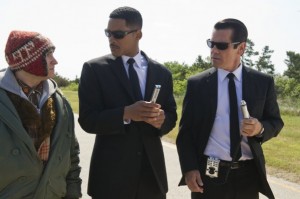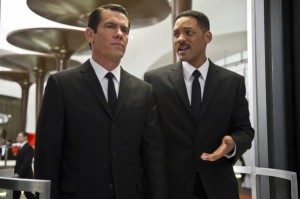Men in Black 3: Will Smith returns as ‘King of the Box Office’ alien killer
Will Smith is well known for starring in pictures that would ordinarily make a medium box office splash at most (such as I, Robot and Hancock) but end up being big hits because he’s in them. The same was true of the original Men in Black: a quirky sci-fi action/comedy based on an obscure comic book. But after a few years out of the movies and starring in a sequel many were unsure was necessary, could he do it again?
Why yes he can, and he did. While not as big of a hit as The Avengers or The Hunger Games, this film still made lots of money and I’m sure will do repeat business as well. The question is: After a colossal mess like Men in Black II, what made this a success?
Bromance. The first film had it and this film has it.
The second film was only a little more than 80 minutes and it takes about half an hour for Tommy Lee Jones (The Fugitive, No Country for Old Men) to be in it at all. Then another 15 minutes for him to get his memory back. In-between is bad jokes, overdone oddities and twice as much Johnny Knoxville as anyone could ever need. By the time it feels like the first movie, it’s over.
So I was delighted to see that the third film, though not as good as the first obviously, is a highly enjoyable apology for the second movie. After introducing the main villain, it wastes no time getting us to what we want to see: Agent J and Agent K bickering on a zany adventure.
The problem faced by the prospect of this story is that Tommy Lee Jones is getting old. Scratch that: He is old. He’s still a great actor and he’s still great in this but he’s been in the business a bit long to still be jumping around while shooting lasers.
Enter Josh Brolin. The True Grit actor who co-starred with Jones in No Country for Old Men was chosen to play a younger version of Agent K. The writers cleverly solve the issue of Jones being unable to do the whole film believably by sending Will Smith back in time to have an adventure with Brolin instead.
 And he does a pretty great job. It’s tough to replicate the bromance chemistry that Jones and Smith had in the first MiB movie but I have to say that they sold it. So much so that I’m calling it right now: Men in Black 4 is going to involve Jones getting hit with a “youth ray” and Brolin will return.
And he does a pretty great job. It’s tough to replicate the bromance chemistry that Jones and Smith had in the first MiB movie but I have to say that they sold it. So much so that I’m calling it right now: Men in Black 4 is going to involve Jones getting hit with a “youth ray” and Brolin will return.
Aside from the chemistry between the actors, the film also succeeds with its atmosphere (the second major thing that made the first movie work). What makes the established world work is that it’s mundane.
It’s not saying: “Oh man cool! It’s a car that drives upside down with rocket engines!” It’s saying: “oh yeah here’s this tiny gun that shoots with the force of a bazooka, whatever.”
That works. Because if you keep pointing out how cool your movie is, it just feels like they want us to further inflate their egos. But if you’re putting cool things in the film because that’s the world that the Men in Black live in, then it works.
One of the joys of this movie for me was seeing that attention to detail applied to a 1960s backdrop. It was like Mad Men fan-fiction that Kenny Cosgrove might write. They balanced ’60s chic with futuristic-for-its-time technology very well, something most audiences take for granted.
 One of my favorite things within genre films or TV is seeing a slightly different version of the locations and gadgets we find so familiar. Because I love things that I call “futuristically retro.” On Batman the Animated Series everyone had black and white TVs and baddies used tommy guns, but other episodes featured holograms and lasers.
One of my favorite things within genre films or TV is seeing a slightly different version of the locations and gadgets we find so familiar. Because I love things that I call “futuristically retro.” On Batman the Animated Series everyone had black and white TVs and baddies used tommy guns, but other episodes featured holograms and lasers.
Seeing the MiB’s classic gadgets like the neuralyzer and the souped-up Ford in ’60s form were a joy to watch. They also played up the “fish out of water” comedic trope without overdoing it. It left everything at appropriate levels of dazzle.
The plot is ridiculous, but that’s what it’s supposed to be. I’m often upset by time travel being used within a story because people usually get it wrong and have logical fallacies. Thankfully there were only one or two moments near the end that made my inner armchair theoretical physicist groan.
And the villain came somewhere between the first villain’s appropriate levels of schlock and the second villain’s ridiculous levels. He was played by Jemaine Clement from Flight of the Conchords, so that made everything amusing for me personally. But I’m not sure how many non-fans of the cult show would find the villain anything more than hammy. Intentionally hammy perhaps, but that’s about it.
Other highlights included a gun-battle that was a gift to my younger teenage self (who always needed good shoot-outs) and a few moments of genuine human emotion, about how miraculous even the simplest moments can be. And how many different things need to go just a certain way for wonderful things to happen.
So while it may not have quite captured the magic of the first film (the magic of which was largely due to the fact that it was the original), it more than made up for the second movie. That leaves the legacy of the film series in tact. If this is what the Men in Black leave us with, it’s a nice send-off for one of ’90s cinema’s more quirky and inventive ideas.
(Photos courtesy of their respective studios and distribution companies)

We dare you to find a television show or movie that Domenic has not seen and most of them he owns. For this reason he has become a walking encyclopedia of anything you would want to know on the topics of TV and movies. When he’s not watching flicks, he’s writing screenplays. Stay tuned for those.

